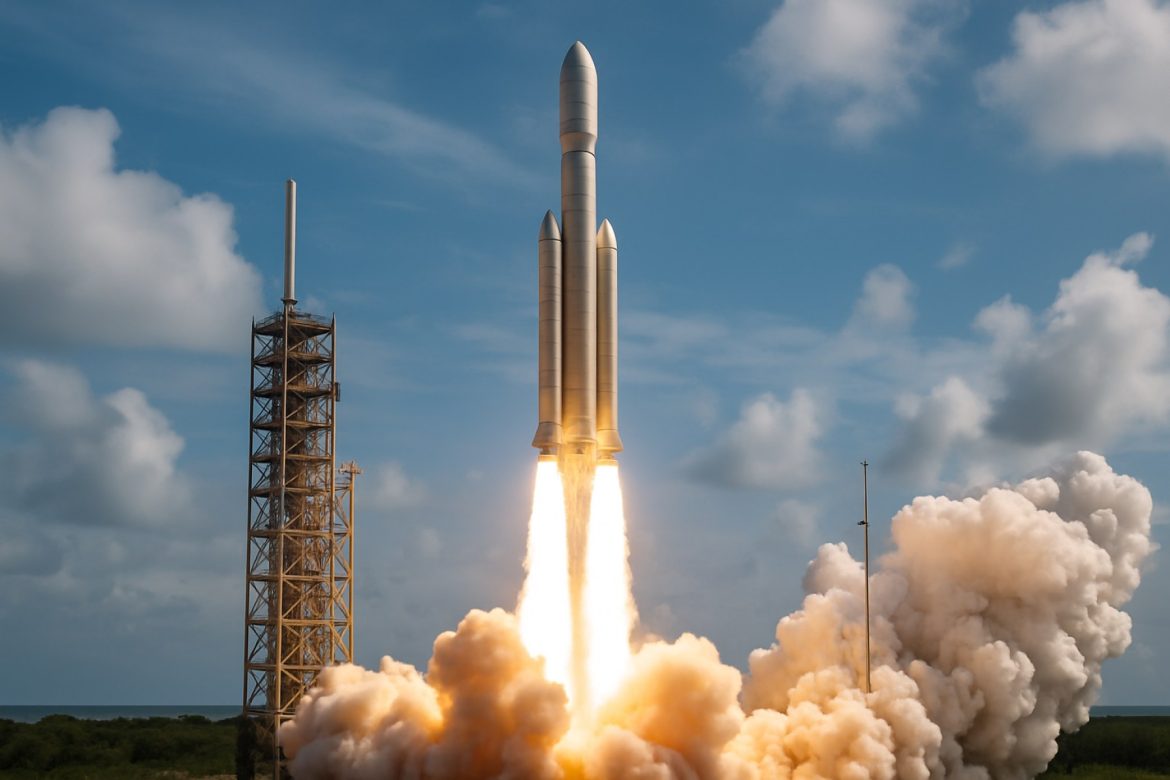Space News Digest: Key Developments, Market Shifts, and Emerging Opportunities
- Current State of the Space Industry
- Breakthroughs and Innovations Shaping Space Technologies
- Major Players and Shifting Alliances
- Projected Expansion and Investment Hotspots
- Geographic Trends and Regional Leaders
- What’s Next for the Space Sector
- Barriers to Growth and Areas for Advancement
- Sources & References
“Tech News Today: Foldable Phones, AI Video, Interstellar Visitors, and the End of Exclusivity The technology landscape is shifting rapidly, with breakthroughs in hardware, AI, astronomy, and the gaming industry.” (source)
Current State of the Space Industry
The space industry continues to experience rapid growth and transformation as of July 1, 2025. The first half of the year has been marked by significant milestones in commercial launches, satellite deployments, and international collaborations. According to the latest SpaceNews digest, the global space economy is projected to surpass $600 billion by the end of 2025, driven by increased investments in satellite internet, Earth observation, and lunar exploration.
- Commercial Launches: The number of orbital launches reached a record 110 in the first six months of 2025, with SpaceX accounting for over 40% of these missions. Notably, SpaceX’s Starship completed its first operational cargo run to the lunar surface in June, delivering payloads for NASA’s Artemis program and private partners.
- Satellite Mega-constellations: The deployment of low Earth orbit (LEO) satellites continues at an unprecedented pace. OneWeb and Starlink have collectively launched over 2,000 new satellites since January, expanding global broadband coverage and intensifying competition in the satellite internet sector.
- International Collaboration: The European Space Agency (ESA) and the Indian Space Research Organisation (ISRO) announced a joint Mars orbiter mission, scheduled for 2027, signaling a new era of cross-continental cooperation (ESA Newsroom). Meanwhile, China’s Tiangong space station welcomed its first international crew members in May, further opening its platform to global research.
- Private Investment: Venture capital funding in space startups reached $8.2 billion in the first half of 2025, according to Space Capital. Key areas of investment include in-orbit servicing, lunar infrastructure, and space-based manufacturing.
- Regulatory Developments: The United Nations Committee on the Peaceful Uses of Outer Space (COPUOS) advanced new guidelines for space traffic management, aiming to address the growing risk of orbital debris (UNOOSA).
Overall, the space industry in mid-2025 is characterized by robust commercial activity, expanding international partnerships, and a growing focus on sustainability and regulation. These trends are expected to shape the sector’s trajectory in the coming years.
Breakthroughs and Innovations Shaping Space Technologies
The space sector continues to experience rapid transformation, with July 2025 marking several pivotal breakthroughs and innovations. This digest highlights the most significant developments shaping the industry as of July 1, 2025.
- Reusable Launch Vehicles Advance: SpaceX successfully completed its 50th consecutive Starship orbital launch and recovery, further reducing launch costs and turnaround times. The company reported a 30% decrease in per-launch costs compared to 2024, accelerating the commercialization of low Earth orbit (SpaceX Updates).
- China’s Lunar Base Progress: The China National Space Administration (CNSA) announced the completion of the first phase of its International Lunar Research Station, with autonomous construction robots assembling key infrastructure. The project aims for crewed missions by 2028, positioning China as a leader in lunar exploration (Global Times).
- Satellite Mega-Constellations Expand: Amazon’s Project Kuiper launched its 1,000th broadband satellite, intensifying competition with Starlink. The global satellite internet market is projected to reach $30 billion by 2027, driven by increased demand for connectivity in remote regions (CNBC).
- AI-Driven Spacecraft Operations: NASA’s Artemis III mission, scheduled for late 2025, will utilize advanced AI for autonomous navigation and real-time hazard avoidance on the lunar surface. This innovation is expected to enhance mission safety and efficiency (NASA).
- Private Space Stations Near Reality: Axiom Space completed the assembly of its first commercial space station module, set for launch in Q4 2025. This milestone signals a shift toward private sector leadership in orbital infrastructure (Axiom Space).
These developments underscore the accelerating pace of innovation in space technologies, with reusable rockets, lunar infrastructure, satellite networks, AI integration, and private space stations reshaping the industry’s landscape. As competition intensifies and new players emerge, the coming months promise further breakthroughs and expanded opportunities across the global space economy.
Major Players and Shifting Alliances
The global space industry continues to evolve rapidly, with major players consolidating their positions and new alliances reshaping the competitive landscape. As of July 1, 2025, several key developments have emerged, reflecting both intensifying competition and strategic cooperation across the sector.
- SpaceX remains the dominant force in commercial launches, having completed 62 successful Falcon 9 and Starship missions in the first half of 2025. The company’s Starlink constellation now exceeds 7,800 operational satellites, further solidifying its lead in global broadband coverage.
- Blue Origin has accelerated its New Glenn launch schedule, with four successful orbital flights since January. The company’s recent partnership with ESA for joint lunar cargo missions marks a significant shift, as European agencies diversify away from traditional Russian and Arianespace launch providers (Blue Origin News).
- China’s CNSA continues to expand its Tiangong space station, with the addition of two new modules in Q2 2025. The agency has also announced a new collaboration with the Indian Space Research Organisation (ISRO) on lunar resource mapping, signaling a rare cross-border partnership in Asia (SCMP).
- NASA and ESA have reaffirmed their Artemis program alliance, with the first crewed lunar landing now scheduled for late 2026. The agencies are also exploring joint Mars sample return missions, leveraging ESA’s robotic expertise and NASA’s heavy-lift capabilities (NASA).
- Private sector entrants such as Relativity Space and Rocket Lab have secured new government and commercial contracts, intensifying competition in the small- and medium-lift launch markets.
These shifting alliances and competitive maneuvers underscore a broader trend: the space sector is moving toward greater international collaboration, even as commercial rivalry intensifies. The coming months are expected to bring further announcements, particularly as lunar and Mars exploration programs ramp up and new commercial satellite constellations come online.
Projected Expansion and Investment Hotspots
The global space industry continues its robust expansion in 2025, with new investment hotspots emerging across both established and developing markets. According to the latest SpaceNews Investment Trends Report 2025, the sector is projected to surpass $600 billion in annual revenue by the end of the year, driven by satellite communications, Earth observation, and the burgeoning space tourism market.
- North America: The United States remains the epicenter of space investment, with NASA’s Artemis program and commercial partnerships fueling growth. Private capital inflows into companies like SpaceX, Blue Origin, and emerging satellite startups have reached a record $18.2 billion in the first half of 2025 (CNBC).
- Europe: The European Space Agency (ESA) and national programs in France, Germany, and the UK are accelerating investments in launch infrastructure and satellite constellations. The UK’s new spaceport in Sutherland and Germany’s micro-launcher initiatives are attracting venture capital and government funding, with European space startups raising over €3.5 billion so far in 2025 (European Spaceflight).
- Asia-Pacific: China and India are rapidly scaling their space ambitions. China’s commercial space sector, led by companies like CASC and iSpace, has secured more than $5 billion in new funding this year. India’s privatization of its space sector is drawing international investors, with the Indian National Space Promotion and Authorization Center (IN-SPACe) reporting a 40% increase in private investment compared to 2024 (Space.com).
- Middle East: The UAE and Saudi Arabia are emerging as regional leaders, investing heavily in satellite technology and lunar exploration. The UAE’s Mohammed bin Rashid Space Centre announced a $1.2 billion fund for new missions and startups in 2025 (Gulf News).
Looking ahead, analysts expect continued momentum in commercial launch services, satellite broadband, and lunar infrastructure. The convergence of public funding, private capital, and international collaboration is positioning the space sector as a key driver of technological innovation and economic growth through 2030 and beyond.
Geographic Trends and Regional Leaders
Geographic Trends and Regional Leaders
The global space sector continues to be shaped by dynamic geographic trends, with regional leaders asserting their influence through ambitious missions, increased investment, and international collaboration. As of July 2025, the following regions and countries stand out in the latest developments:
- United States: The U.S. remains the dominant force in space, driven by both NASA and a robust private sector. NASA’s Artemis program is on track for its first crewed lunar landing in over 50 years, scheduled for late 2025 (NASA Artemis). Meanwhile, SpaceX and Blue Origin continue to expand commercial launch capabilities, with SpaceX’s Starship completing its first operational cargo run to lunar orbit in June 2025 (SpaceX Updates).
- China: China has solidified its position as a leading space power. The Tiangong Space Station is now fully operational, hosting international astronauts for the first time in 2025. The Chang’e-7 mission, launched in May, is currently surveying the lunar south pole for water ice (Xinhua: Chang’e-7).
- European Union: The European Space Agency (ESA) has increased its budget by 12% for 2025, focusing on Earth observation and Mars sample return missions. The Ariane 6 rocket, after a successful debut in late 2024, is now the workhorse for European launches (ESA: Ariane 6).
- India: The Indian Space Research Organisation (ISRO) has launched its first crewed Gaganyaan mission in June 2025, marking a major milestone for the country’s human spaceflight ambitions (ISRO: Gaganyaan). India is also expanding its commercial launch services, targeting small satellite markets in Asia and Africa.
- Middle East: The United Arab Emirates (UAE) continues to invest in space science, with the Mars Hope Probe still operational and a new lunar rover, Rashid-2, scheduled for launch in late 2025 (MBRSC: Rashid Rover).
These regional leaders are not only advancing their own capabilities but also fostering new partnerships, shaping the future of global space exploration and commercialization.
What’s Next for the Space Sector
The space sector continues to accelerate in 2025, with July marking a pivotal month for both commercial and governmental initiatives. As of July 1, 2025, the industry is witnessing a surge in satellite launches, new funding rounds, and international collaborations, reflecting the sector’s robust growth and strategic importance.
- Satellite Launches and Mega-Constellations: The first half of 2025 saw over 1,200 satellites launched globally, a 15% increase compared to the same period in 2024 (SpaceNews). Starlink and OneWeb continue to expand their constellations, with Amazon’s Project Kuiper ramping up deployment, aiming for 3,000 satellites in orbit by year-end.
- Commercial Spaceflight: SpaceX’s Starship completed its first fully reusable orbital flight in June, setting the stage for more frequent and cost-effective missions (Teslarati). Blue Origin and Axiom Space are also advancing their crewed missions, with Axiom’s AX-5 mission scheduled for late July.
- International Collaboration: The European Space Agency (ESA) and NASA announced a joint lunar resource utilization project, targeting a 2027 demonstration mission (ESA). Meanwhile, China’s Tiangong space station welcomed its first international crew, signaling a new era of global cooperation.
- Investment and M&A Activity: Space sector investment remains strong, with Q2 2025 venture funding surpassing $7.5 billion, led by mega-rounds in satellite communications and in-orbit servicing startups (SpaceTech VC). Notably, Rocket Lab acquired a leading propulsion startup, consolidating its position in the small launch market.
- Regulatory Developments: The U.S. Federal Communications Commission (FCC) introduced new guidelines for satellite deorbiting and space debris mitigation, aiming to address the growing congestion in low Earth orbit (FCC).
Looking ahead, the space sector is poised for further expansion, driven by technological innovation, increased private investment, and deepening international partnerships. July 2025 stands as a testament to the industry’s dynamic evolution and its central role in shaping the future of connectivity, exploration, and security.
Barriers to Growth and Areas for Advancement
The space industry continues to experience rapid innovation, but several barriers persist that could impede its growth. As of July 2025, the sector faces challenges ranging from regulatory hurdles to supply chain constraints, while also presenting clear opportunities for advancement.
- Regulatory Complexity: The proliferation of commercial satellite launches and mega-constellations has led to increased scrutiny from national and international regulators. The U.S. Federal Communications Commission (FCC) and the International Telecommunication Union (ITU) are tightening rules on orbital debris and spectrum allocation, which can delay project timelines (SpaceNews).
- Supply Chain Disruptions: The global supply chain for critical components, such as semiconductors and propulsion systems, remains fragile. Delays in the delivery of these parts have impacted launch schedules for both government and private missions (Space.com).
- Funding and Investment Volatility: While private investment in space startups reached $12.5 billion in the first half of 2025, according to Seraphim Space, venture capitalists are becoming more selective, favoring companies with proven revenue streams. This shift could limit early-stage innovation.
- Workforce Shortages: The demand for skilled aerospace engineers and technicians continues to outpace supply. The Space Foundation’s 2025 report notes a 15% gap between job openings and qualified applicants (Space Foundation).
Despite these barriers, several areas offer significant potential for advancement:
- In-Orbit Servicing and Debris Removal: Companies like Astroscale and ClearSpace are piloting missions to remove defunct satellites, addressing the growing issue of space debris (ESA).
- Reusable Launch Technologies: SpaceX’s Starship and Rocket Lab’s Neutron are pushing the boundaries of reusability, aiming to reduce launch costs and increase cadence (Teslarati).
- Lunar and Deep Space Exploration: NASA’s Artemis program and international partners are advancing lunar infrastructure, with the first commercial lunar landers scheduled for late 2025 (NASA).
Addressing these barriers while capitalizing on emerging opportunities will be crucial for sustained growth in the space sector through 2025 and beyond.
Sources & References
- Space News Digest: July 1, 2025 / Updated: 2025, July 1st, 12:02 CET
- SpaceNews
- Starlink
- ESA
- Space Capital
- UNOOSA
- Global Times
- CNBC
- NASA
- Axiom Space
- Blue Origin News
- ISRO: Gaganyaan
- SCMP
- Rocket Lab
- European Spaceflight
- Space.com
- Gulf News
- Xinhua: Chang’e-7
- MBRSC: Rashid Rover
- Teslarati
- SpaceTech VC
- Seraphim Space



